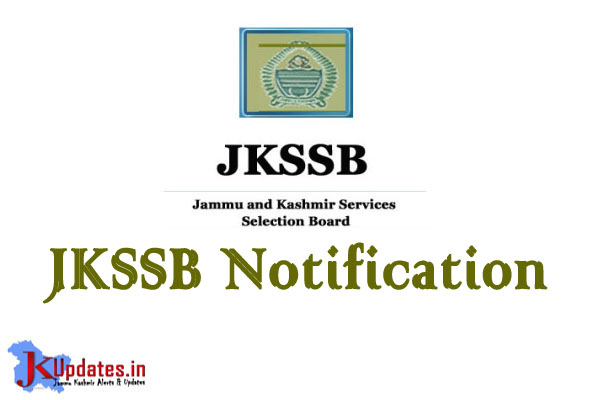JKSSB Syllabus For The Post of Deputy-Inspector Fisheries & Fisheries Development Assistant
JKSSB Syllabus For The Post of Deputy-Inspector Fisheries & Fisheries Development Assistant
Advance notice for the conduct of Written Examination for the various posts.
It is hereby notified for the information of candidates that J&K Services Selection Board (JKSSB) is scheduled to conduct the written test for the various posts whose details are given in Annexure” A” to this notice, tentatively on the dates mentioned against each.
The exact dates along with the schedule for downloading admit cards shall be notified separately in due course of time. This is an advance notice for the information of concerned candidates.
The syllabus for the examinations for the posts mentioned in Annexure “A” are annexed here with as Annexure “B” to “E”.
I. Principles of taxonomy
Nomenclature, types Classification and interrelationships. Criteria for generic and specific identification. Morphological, morphometric and meristic characteristics of taxonomic significance. Major taxa of inland and marine fishes up to family level. Commercially important freshwater and marine fishes of India and their morphological characteristics. Introduction to modern taxonomic tools : karyotaxonomy. DNA barcoding, protein analysis and DNA polymorphism. Study of external morphology and meristic characteristics of crustacea and mollusca. Classification of crustacea and mollusca up to the level of species with examples of commercially important species.
II Anatomy and Physiology of vertebrates with special reference to finfish Integumentary System :
Derivatives of integument; Skeletal System, Evolution of visceral arches; Digestive System; Respiratory System; Circulatory System; Excretory system.
III Classical and Molecular Genetics :-
Mendalian gentics Linkage, Linkage maps and crossing over ; Nature of heterochromatin; Organisation of genetic material in prokaryotes and eukaryotes. Multiple alleles, Lethality, Epistasis, Sex linked inheritance, Extra chromosomal Inheritance; Mutations: Structural and numerical changes in chromosomes; Gene mutations; Replication: Replication in prokaryotes and eukaryotes; Transcription and translation: Transcription and post transcriptional modifications, Translation; Sex Determination, Chromosomal mechanisms, Dosage compensation; Principles of genetics and breeding, Gene and chromosome as basis of inheritance, Mendel’s law of inheritance — complete and incomplete dominance, monohybrid and dihybrid ratios. Gene interactions —dominant and recessive epistasis. Pleiotropism. Lethal genes.
IV Fresh Water Aquaculture :-
Major species cultured, production trends and prospect in different parts of the world. Freshwater aquaculture resources-ponds, tanks, lakes, reservoirs etc. Nursery, rearing and grow-out ponds preparation and management-control of aquatic weeds and algal blooms, predatory and weed fishes, liming, fertilization/maturing, use of biofertilizers, supplementary feeding. Water quality management. Selection, transportation and acclimatization of seed. Traits of important cultivable fish and shellfish and their culture methods-Indian major carp, exotic carp, air breathing fish, cold water fish, freshwater prawns.
V. Limnology :-
Introduction to limnology inland water types, their characteristics and distribution; ponds and lakes; streams and rivers; dynamics of lentic and lotic environments. Lakes – their origin and diversity. Famous lakes of India with special reference to J&K; nature of lake environment; morphometry, physical and chemical conditions and related phenomena; biological relations: influence of physical and chemical conditions on living organisms in inland waters. Plankton: planktonic organisms; classification of plankton; distribution of plankton: geographic, vertical, horizontal and seasonal distribution of phytoplankton and zooplankton; seasonal changes of body form in planktonic organisms; food of planktonic organisms; primary productivity.
VI. Aquatic ecology and Biodiversity :-
Aquatic environment, Flora and fauna: Components of aquatic systems, Aquatic productivity, nutrient cycles, energy flow, food chain. Animal Association parasite relationship Aquatic biodiversity-its importance, species diversity, • genetic diversity, habitat diversity, diversity indices. Ecological and evolutionary processes. Ecological niches – lagoons, estuaries, mangroves, coral reefs, flood • plains, coastal wet lands, bheels, oxbow lakes. Threats to biodiversity- habitat destination, introduction of exotic species, Conservation of habitats, marine parks and sanctuar.es. Conservation programmes for endangered species, ex situ and in situ conservation, captive breeding and management of endangered species. Various national and international conventions and regulations concerning biodiversity, including use of selective gears and exclusion devices.
VII. Fish Nutrition and Biochemistry :-
Fundamentals of fish nutrition and growth in fish. Principal nutrients and nutritional requirements of cultivable fish and shellfish. Nutritional energetics: definition and forms of energy partitioning. Methods of food formulation and manufacturing. Forms of feeds: wet feeds, moist feeds, dry feeds, mashes, pelleted feeds, floating and sinking pellets. Feed additives: binders, antioxidants, enzymes, pigments, growth promoters, food stimulants. Food storage: use of preservatives and antioxidants. Feed evaluation: feed conversion ratio, feed efficiency ratio, protein efficiency ratio, net protein utilization and biological value. Feeding devices and methods. Non-conventional Iced ingredients and antinutritional factors. Digestive enzymes, food digestibility. Factors affecting digestibility. Nutritional deficiency diseases. Carbohydrate metabolism: Glycolysis, Krebs-cycle, Pentose phosphate pathway, Gluconeogenesis, Glycogen metabolism, Electron transport chain; Lipid metabolism: Biosynthesis and 13 oxidation of palmitic acid. Protein metabolism: Transamination, deamination and urea cycle Enzymes: Introduction, Mechanism of action, Enzyme Kinetics, Inhibition and Regulation
VIII. Hill stream Fisheries :-
Introduction, Ecology and classification of hill streams. Geographical features, Drainage pattern, Climate and seasons with special reference to Himalayan Hill streams. Check list of some important hill streams. Biodiversity of hill stream fishes of Jammu, Kashmir and Ladakh. Grouping of hill stream fishes as per Menon (1954). Modifications in the hill stream fish fauna (External shape and form of the body, Scales, position of the mouth and lips, barbles, paired fins, caudal fin and caudal peduncle, eyes, gill apertures, and branchiostegal rays, skeleton, air bladder), adhesive apparatus, histological structure and mechanism of adhesion. Food of hill stream fishes. Primary and secondary productivity in hill streams. Evolution, distribution and origin of hill stream fishes. Fish culture in hill streams.
IX. Hatchery Management :-
Freshwater and marine fish seed resources. Natural breeding of finfishes. Selection of riverine spawn collection sites, gears used and methods of collection. Spawn quality and quantity indices. Advantages and disadvantages of riverine seed collection. Sexual maturity and breeding season of various cultivable species. Development of gametes in male and female. Fish egg and embryonic development. Methods of breeding; bundh breeding – wet and dry bundhs, collection and hatching of eggs, factors involved in bundh breeding, advantages and disadvantages of bundh breeding. Induced breeding of warm water finfishes, environmental factors affecting spawning, sympathetic breeding. Hypophysation of fishes. Fish pituitary gland – its structure, collection, preservation and preparation of extract for injection, dosages and methods of injection. Brood-stock management and transportation of brood fish. Synthetic hormones used for induced breeding of carps. Different types of fish hatcheries-traditional, Chinese, glass jar and modern controlled hatcheries. Causes of mortalities of eggs and spawn and remedies. Spawn rearing techniques. Use of anaesthetics in fish breeding and transport. Breeding techniques for Indian major carp, exotic carp. mahaseer tilapia, catfish.
X. Sport Fisheries :
Present status and future prospects of cold-water sport fishing. Different species of cold-water sport fishes and their natural breeding habit, ecology and behaviour. Different sport fishing techniques of fly fishing, spinner fishing and bait fishing. Casting/ flipping/pitching, rigging, fish handling, live baits, rod and reel maintenance and repair, seasonal fish patterns, water and sun safety. State regulations governing sport fishing and management practices that maintain healthy fish populations.
XI. Fish Preservation, Processing and Value addition:- Principle of fish preservation and processing. Processing of fish by traditional methods- salting, sun drying, smoking, marinating and fermentation. Theory of salting, methods of salting-wet salting and dry salting. Drying and dehydration-theory, importance of water activity in relation to microbial growth. Sun drying and artificial drying- solar dryer. Packaging and storage of salted and dried fish. Different types of spoilage in salt cured fish. Quality standard for salted and dry fish. Fish preservation by smoking-chemical composition of wood smoke and their role in preservation. Methods of smoking and equipments used for smoking. Carcinogenic compound in wood and methods to remove them. Hurdle technology in fish preservation and processing. Marinated and fermented fish products-role of acids in marinades, Fish and prawn pickles, fish sauce and Fish paste, traditional Indian fermented products.
XII. Fish Diseases, Diagnosis and Treatment :-
Introduction fish diseases. Common diseases of cold-water fish spp. Haemato-biochemical profile in fish disease. Immune system of fish; cell mediated, humoral immunity, non-specific immune system. Effect of environment on fish immune system. Important bacterial and Fungal diseases of cold-water fishes. Parasitic diseases of cold-water fishes; ecto and endo parasites, monogenetic and digenetic trematodes, black spot disease. Cestodiasis; Nematodiasis; Acanthocephalosis; Protozoon infections. Argulosis and other crustacean mediated diseases Diseases due to environmental stress. Host-pathogen interaction in fish. Disease surveillance, diagnosis, and treatment.
Kashmir University Job Recruitment 2024
Job Recruitment in K V Miran Sahib Jammu
Job Recruitment in GMC Rajouri
RBI Medical Consultant Job Recruitment
Install "Sarkari Naukri, Pvt Jobs, Trusted & Breaking News App" Highest Installs in J&K - Click me to Install
Install JKUpdates App for Android and Iphone


JKSSB Govt Jobs - Check Updates
Bank Jobs, IBPS, All Banks Updates
Jammu & Kashmir News Check All Latest News from J&K
Government Jobs, Private Jobs - Check All Jobs Updates

